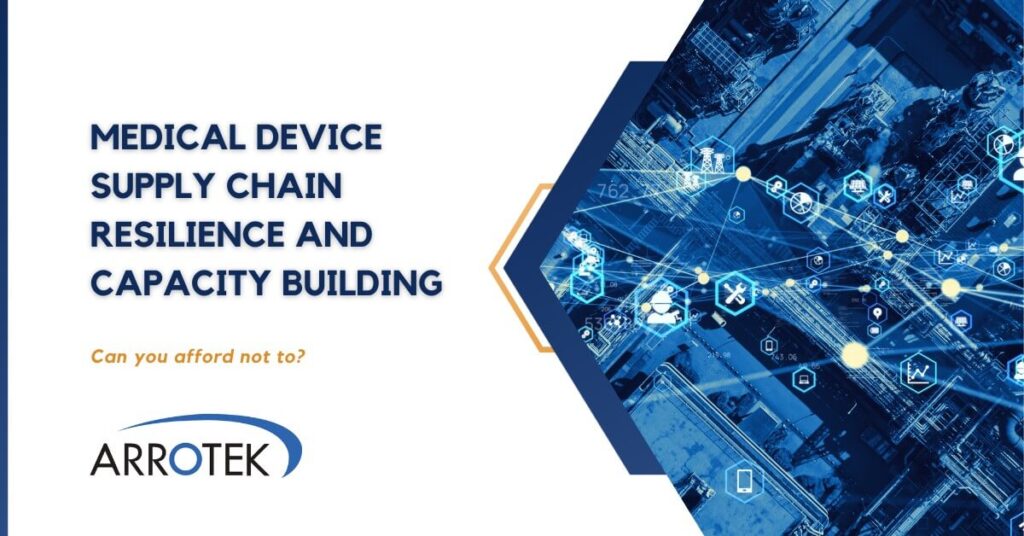By Keith Spodek Supply chain resilience, supply chain capacity, and resource capacity are priority areas for many senior leaders in the medical device industry. Patients, clinicians, and customers need and want the products the MedTech industry produces and continues to develop. The big question for many companies is how to meet demand today and in the future. Even when conditions are perfect, modern realities mean there is a continuous need to ensure adequate capacity.It is also important to take into account the various factors that can cause supply chain shocks. Examples that have impacted medical device supply chains in recent years include:
Six Strategies for Supply Chain Resilience and Capacity Building

Analyze
Understanding and analyzing your current position is crucial. Answering the following questions can bring clarity to where improvements should be made:
- At what point in a demand surge will your supply chain no longer be able to cope?
- What levels of demand variability can your supply chain handle?
- How much of an increased level of raw demand and demand variability can you achieve by making investments in capacity?
- Are their alternative supply chain partners that can deliver enhanced capacity with minimal additional investment?
- What is your level of exposure to critical product or component supply chain vulnerabilities?
It also helps to run what-if scenarios to stress test your supply chain under different conditions and with a variety of challenges.
Better Use of Data
Data can play a crucial role in building supply chain resilience and helping ensure you have sufficient ongoing capacity. You will also have better oversight of your supply chain, enabling you to identify bottlenecks and potential areas of disruption.
One of the ways to make better use of data in your supply chain is to invest in procurement intelligence solutions to provide a better understanding of when surges in demand are likely to occur.
Expanded Partnerships
Developing robust and close relationships with supply chain partners is an important step to building supply chain resilience and capacity. It also helps to regard key suppliers as strategic partners with an expanded relationship built on openness and good communication.
Identifying the right supply chain partners is an important part of the process too. The ideal supply chain partner will have the following characteristics:
- Comprehensive offering
- Well established processes
- Good supply chain resilience
- Financial robustness
- Organizational maturity
- Strong market reputation
- Agility to the ever-changing business climate
Design for Supply Chain
Having a strategic focus at the design stage of a product’s lifecycle can also help with supply chain resilience and capacity building. This means adopting a design for supply chain approach, where product designers consider factors like:
- The availability of core components.
- Options for core components or materials if the main procurement source becomes unavailable.
- Where products and components are manufactured and what contribution those locations make to supply chain risk, positive or negative.
- Standardizing components across multiple products.
Effective Communication
It is impossible to build supply chain resilience and capacity if communication with supply chain partners is ineffective. Honest and open communication when situations are good, bad, or indifferent is the only option.
Contingency Planning
Contingency planning is about enhancing the flexibility of your supply chain to help you adapt to shocks and disruptions.
Multi-sourcing is one example of contingency planning, where you achieve pre-approval status for backup suppliers so they are ready to go if your primary supplier cannot meet requirements. Pre-approving partners will eliminate the need to validate and certify suppliers when demand is surging.
How Arrotek Can Help with Supply Chain Resilience and Capacity Building
At Arrotek, we can help with your supply chain resilience and capacity-building efforts in a number of areas. This includes the supply of our core products – specialty needles, cannulas, and stylets.
We can also supply adjacent and complementary products through our sister companies, including catheters, guidewires, introducers, and packaging.
Of course, supply chain disruptions are not limited to product and component manufacturing capacity. At Arrotek, we also offer a range of services that can give you the capacity you need, when you need it. These services include:
- Design services
- Regulatory support
- Prototyping
- Product development and manufacturing consultancy
To discuss your requirements, please contact a member of the Arrotek team by completing the form below.





